Birch is one of the most recognizable and beautiful trees that can be found in different parts of Russia. They grow everywhere, from Siberia to the western borders.
Birches are tall, slender trees with white bark that darkens over time. In a drawing, they can become a symbol of nature and beauty.
Necessary materials and tools
The right choice of materials and tools can significantly affect the quality and expressiveness of the drawing, making the drawing process more enjoyable and effective.
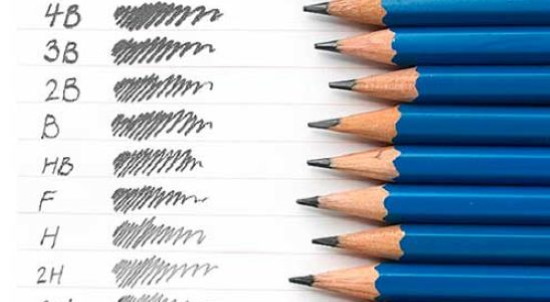
| Tools and materials | Brief description |
| Paper | Depending on the density and color, paper can be used for various techniques and effects. It can be smooth or textured, with a white or colored background, and in different formats. |
| Pencils | They come in different hardness and softness, allowing artists to create lines of varying thickness and saturation. Pencils also differ in graphite composition and color, providing ample opportunities for conveying light and shadow, creating volume and texture. |
| Erasers | An essential tool for any artist who uses pencils as their primary tool, erasers are used to correct mistakes or create blurring effects when needed. There are many types of erasers, but they all have the ability to remove graphite from the surface of the paper. |
| Klyachki | This is a type of eraser that is made of soft rubber or plastic. Kneaded erasers are used for delicate correction and blurring of lines on paper, as well as for creating smooth transitions between colors. |
| Stencils | They are templates that are used to create repeating elements or patterns in a drawing. They are made from various materials, such as plastic, cardboard or paper, and can have different shapes and sizes. Stenciling allows the artist to save time and effort when creating complex patterns. |
| Rulers, compasses | These are tools used to measure distances, draw straight lines, and construct geometric shapes. These tools help the artist create accurate and neat drawings. |
| Sharpeners | They are designed to sharpen pencils and maintain them in working condition. They come in different types, including mechanical and electric. A sharpener is an essential tool for artists who work with pencils. |
| Brushes | Used to apply paint to the surface of paper. They vary in size, shape, and pile material. Brushes allow artists to create a variety of textures and effects, such as brushstrokes, dots, and lines. |
| Gouache | This is a type of paint made from pigments, glue, and water. It has a thick consistency and can be used to create rich, vibrant colors. Gouache mixes well with other paints and is easy to apply to paper or canvas. |
| Watercolor | It is a paint made up of pigments and a binder dissolved in water. It allows you to create delicate and transparent effects on paper or canvas. Watercolor can be applied in layers, creating complex color transitions. |
| Acrylic | It is a synthetic paint that dries quickly and forms a strong film on the surface. It is used to create bright and saturated colors. |
Master classes
To make the drawing realistic and beautiful, you need to know some of the features of this tree:
- It has a distinctive white bark that gives the birch its unique appearance. It can be smooth or slightly rough, depending on the age of the tree and weather conditions.
- Young birches have a rounded and lush crown, while mature ones are more elongated and delicate. It is better to use soft lines and smooth transitions for the drawing to convey the lightness and airiness of the crown.
- Birch leaves have a triangular shape and jagged edges. Therefore, when depicting foliage, you need to make the edges sharp and expressive.
In cartoon style with pastel colors
Birch in a cartoon style drawing using pastel colors can be depicted using several stages. When creating a drawing, detailing and maintaining proportions are important.
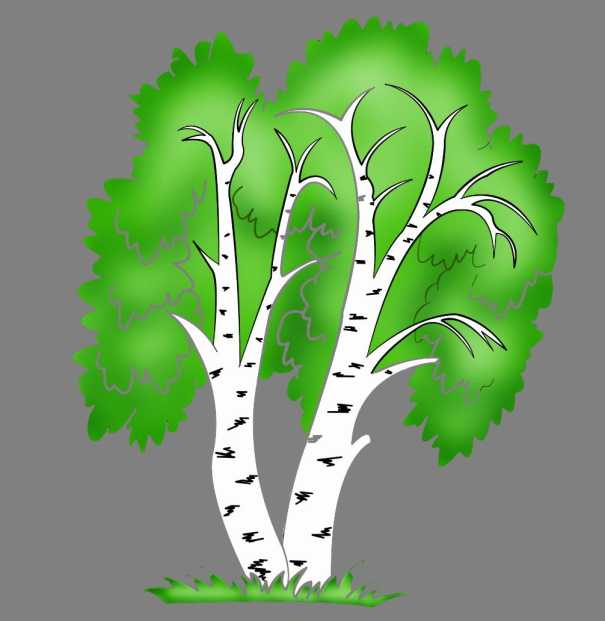
A step-by-step description will help you achieve the desired result.
- Make a sketch of a birch tree. Depict its basic shapes and proportions. The birch tree has a long trunk with white stripes and thin branches. Outline its main details. The sketch should be simple and not overloaded with details.
- Draw the basic shape of the trunk, taking into account its thickness.
- Draw the second birch trunk. It should be slightly thinner than the first, located to the right of it and tilted downwards.
- Add branches that should start at different heights and be of different lengths. They can be slightly intertwined. The branches can be positioned at different angles relative to the trunk. This will add dynamism to the drawing.
- Draw leaves on the branches. You can make them wavy - this will add playfulness and movement to the drawing. The shape of the leaves should be round or elongated, while the cartoon style is characterized by a small leaf size. The tree crown can be openwork.
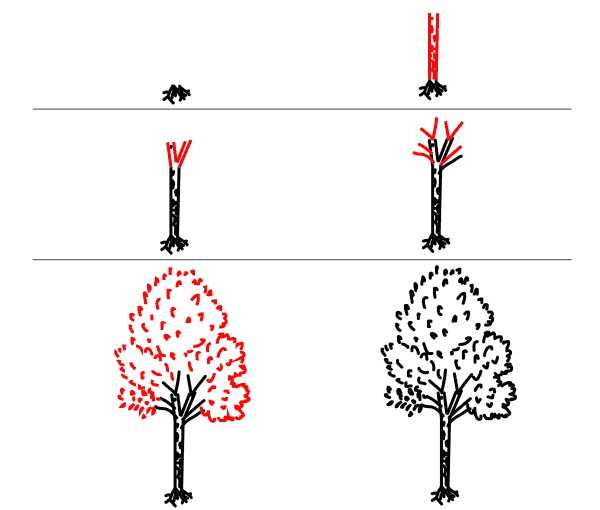
- Add lenticels - small black dots on the bark. You can make them with a black pencil.
- Draw grass at the base of the tree. It will go well with the birch bark and add naturalness to the composition. For cartoon drawings, an image of grass without carefully drawing the stems is suitable.
- You can color the picture.
Gouache
The birch tree in the picture can be depicted according to this master class using gouache.
During the lesson, each stage of creating a picture is considered.
- Start by creating the base of the tree trunk. This is the vertical stroke that will form the base of the trunk. Young trees are thinner and smoother, while older trees have a rougher texture.
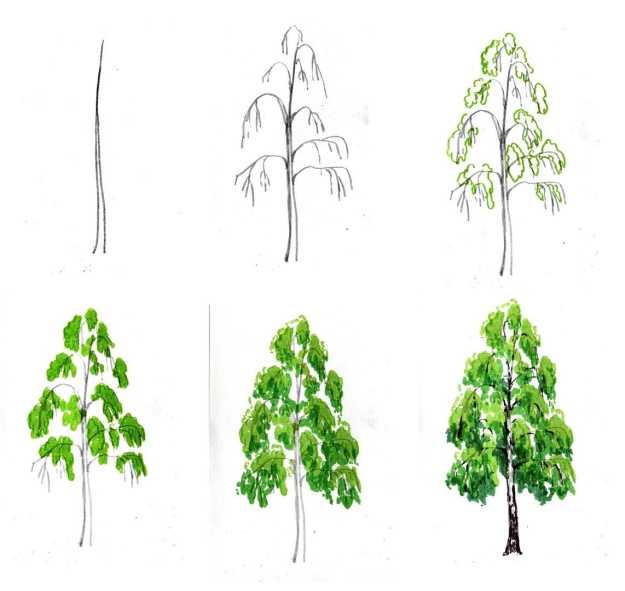
You can use different techniques of applying paint to create a sense of volume or texture, using contour lines, shadows, or layering multiple layers of paint to achieve the desired effect.
- Add several branches in different directions. They can be thin or thick, straight or curved, depending on your idea. Some branches can cross each other, creating an interesting composition.
Birch trees usually have thicker lower branches and thinner upper branches.
- Add small strokes and brushstrokes to create the outlines of the foliage. They should be close to the branches, but not merge with them. Depending on the season and lighting, they can have different shades of green.
Use strokes of different lengths and directions to add dynamics and naturalness to the image.
- Draw the leaves near the trunk. They can hang over the ground. Using soft brushes and gouache, start by painting the basic contours of the leaves. Move on to smaller details, forming the shape and size of each leaf.
Adjust the density of the brushstrokes to create a three-dimensional effect of the foliage. Avoid clear boundaries between the leaves to achieve a feeling of naturalness and airiness.
- Start drawing the birch foliage at the ends of the branches. It can be indicated with dots, short strokes or small oval brushstrokes.
The foliage is lighter than the tree bark, so it should not be too saturated. It is rarely distributed evenly over the entire surface of the branches.
- Lenticels are small black or brown horizontal stripes on tree bark. They can be drawn as small dark dots on the trunk and branches of a birch tree to add realism to the drawing.
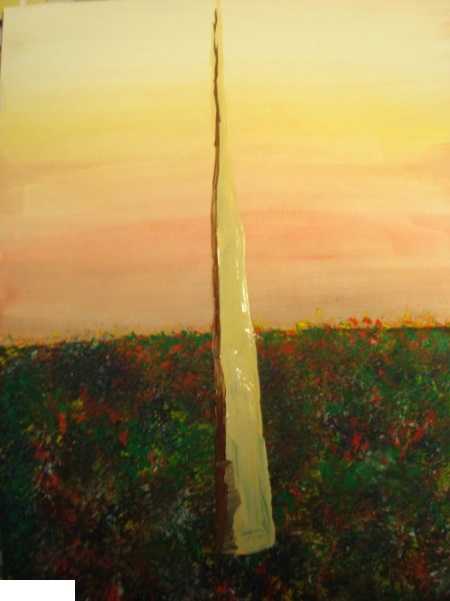 | 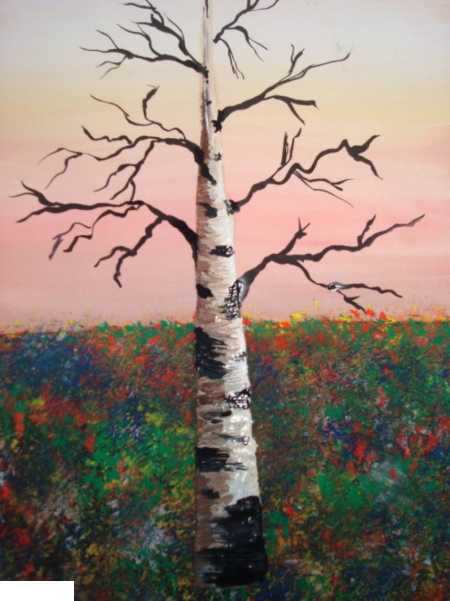 |  |
To add depth and volume, you can use shading or mix colors. For example, by mixing yellow shades with brown and green, you can get different variations of bark color.
At the base of the trunk, the color should be dark, and as you move up, it becomes lighter and more transparent. To create the effect of voluminous branches, you can also slightly shade their edges.
With colored pencils
The birch tree in the picture can be depicted with colored pencils based on step-by-step instructions and recommendations:
- Start by sketching the basic shapes. Draw the outline of the trunk and branches using light lines. Determine the height and proportions of the tree to get an idea of the final result. Keep the sketch drawing simple, leaving room for details in the next steps.
- Use thicker lines to draw the trunk of the birch. Start with the main part of the trunk, add branches and twigs. Watch the proportions and the slope of the branches.
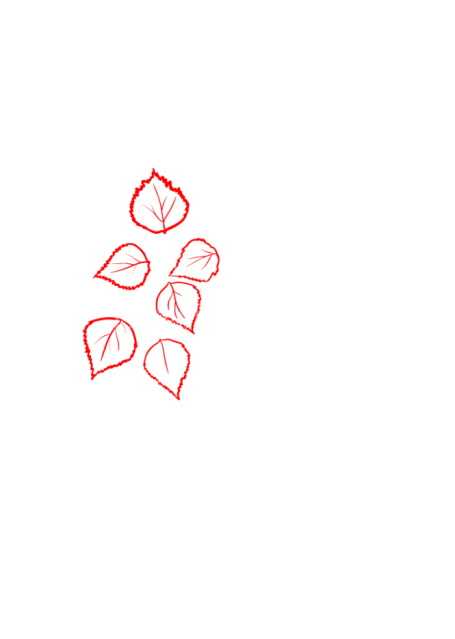 |  |
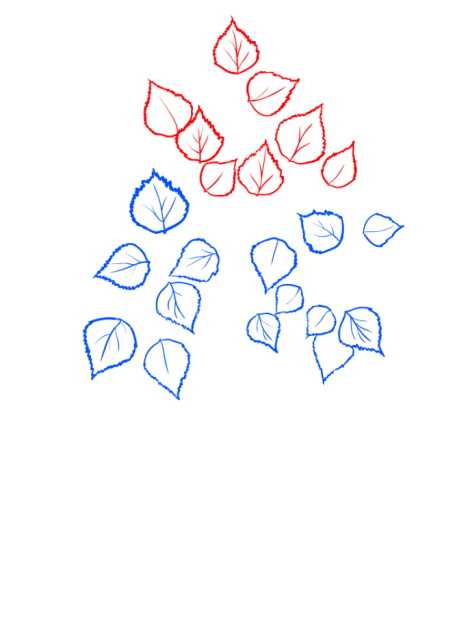 |  |
To convey the texture of the trunk, use vertical strokes. Draw several lines to create the effect of depth and volume. This will make the drawing more realistic.
- Draw thin curved branches diverging from the trunk. Each branch can have its own slope and shape, creating a dynamic silhouette of the tree. Add details in the form of small twigs and buds.
- Draw the birch foliage using short strokes. Draw large leaves on the upper branches, move on to small leaves on the lower branches. The birch foliage is thick and light.
Use different shades of green to convey the shades. Light tones are suitable for depicting the upper part of the crown, and darker ones for the lower branches.
- Add lenticels to the birch trunk. Use black pencils to draw stripes. They should be evenly distributed over the entire surface of the trunk. Consider the direction of the light source and create shadows so that the drawing looks three-dimensional.
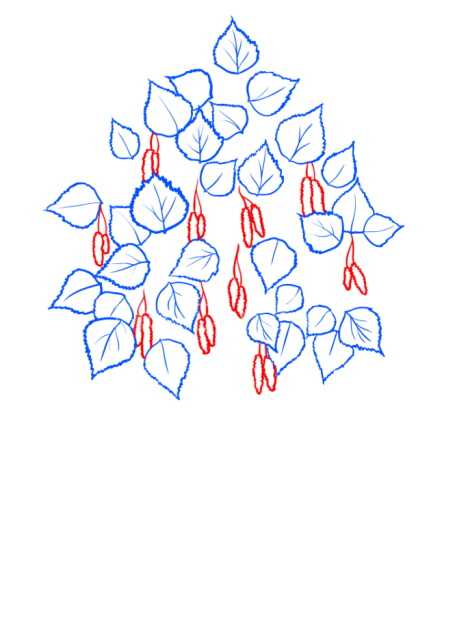 |  |
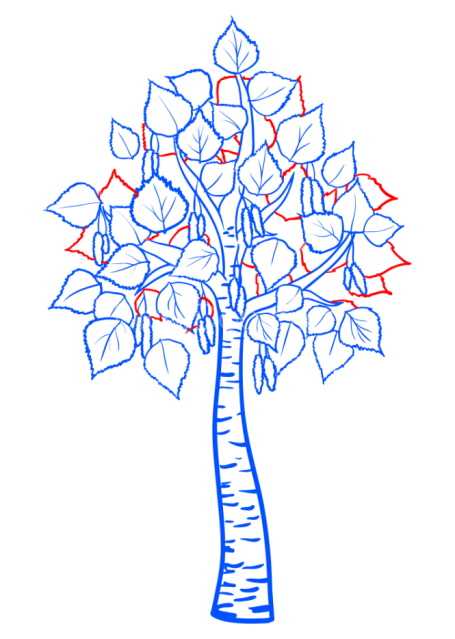 | 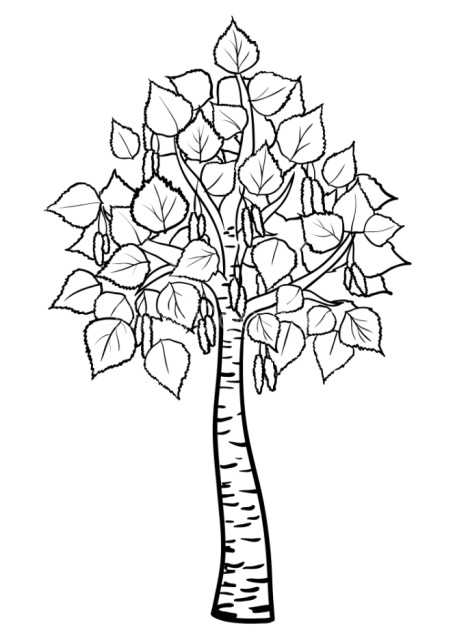 |
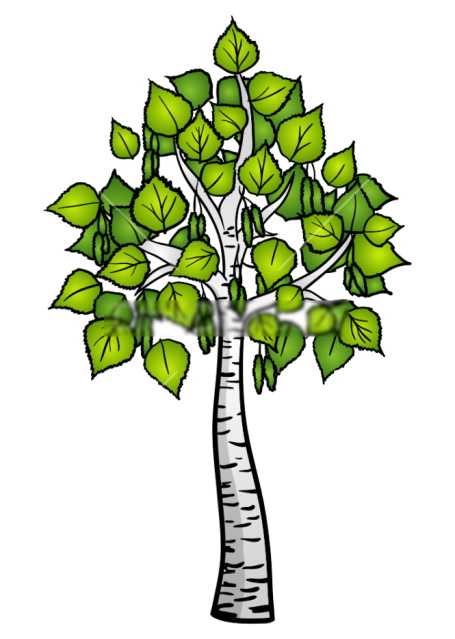 To get the impression of living nature, add some unevenness and roughness to the surface of the wood.
To get the impression of living nature, add some unevenness and roughness to the surface of the wood.
In cartoon style with watercolor paints
The birch tree in the picture can be depicted using watercolors, which allows you to create soft and smooth transitions between shades, which is ideal for conveying the natural beauty of the tree crown:
- Draw a sketch of a birch tree on paper. Convey the basic shapes of the tree: a straight trunk, wide branches. Use light lines so that you can easily make changes later.
- Convey the volume and shape of the birch trunk. It should be slender and straight, and its contours should be smooth and graceful. Smooth lines without sharp corners are suitable for the cartoon style. Start by outlining the main shape, add details such as knots and uneven bark.
Use different shades of green to show the variety of shades in the bark. To create a cartoonish feel, you can add additional elements, such as round "pockmarks" on the trunk or curved branches.

- Add branches to the birch tree trunk using curved lines. They should be directed upwards and slightly to the sides. The branches can be of different lengths and thicknesses. Convey a sense of depth and volume through the use of different shades and hatching techniques.
- Add foliage. Leaves should be rounded and of varying sizes. Arrange them unevenly along the branches, creating the impression of lush greenery.
For a cartoonish effect, you can also draw some leaves larger or smaller than others. Draw the leaves so that they look as if they are blowing in the wind. Watercolor allows you to convey the effect of swaying leaves.
- Add black stripes to the tree trunks. This will make the bark more textured and voluminous. Draw thin lines along the trunk.
- Start coloring. Use soft watercolor paints to convey the color and texture of the tree. In cartoon drawings, colors can be bright and saturated. Emphasize the volume of the tree by adding light shadows under the branches and leaves.
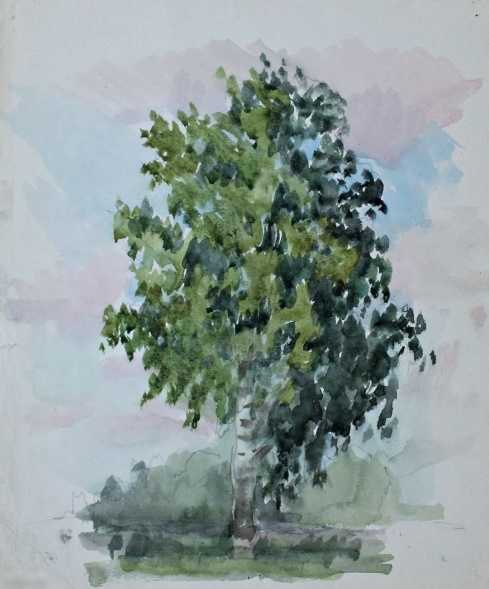 | 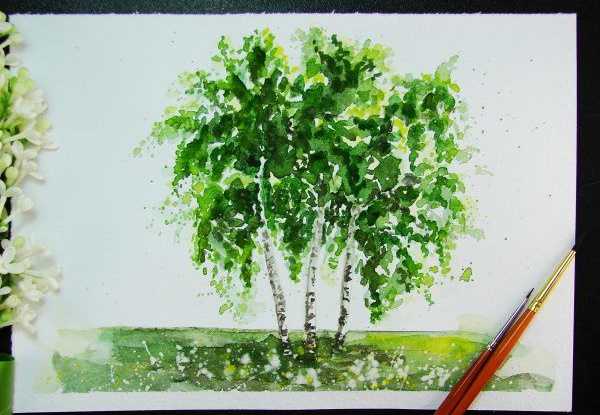 | 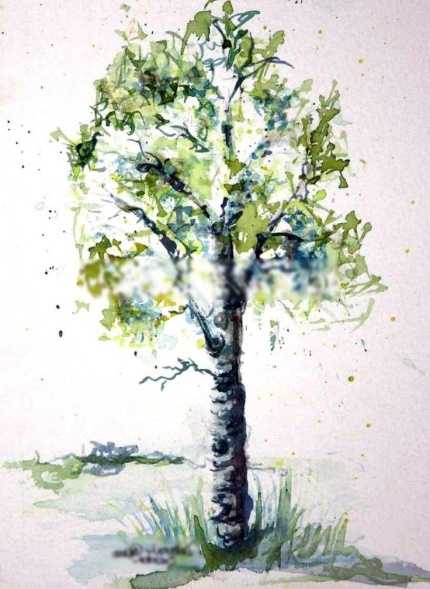 |
To highlight its shape, you can use a darker shade of watercolor paint for the shadows.
Schematic drawing with rare leaves
The drawing of a birch tree can be made schematically:
- Draw the outline of the birch. It should be symmetrical so that the trunk looks natural. Outline the main lines that will serve as the basis for subsequent drawing of the details.
Draw from the base of the trunk, move to the crown of the tree. This will help maintain proportions and achieve balance in the drawing.
- The birch trunk consists of several parts: the base, the middle, and the top. The base should be wide, and the middle should be narrower. The top can be slightly curved. To give the trunk volume, use shading or shadow.
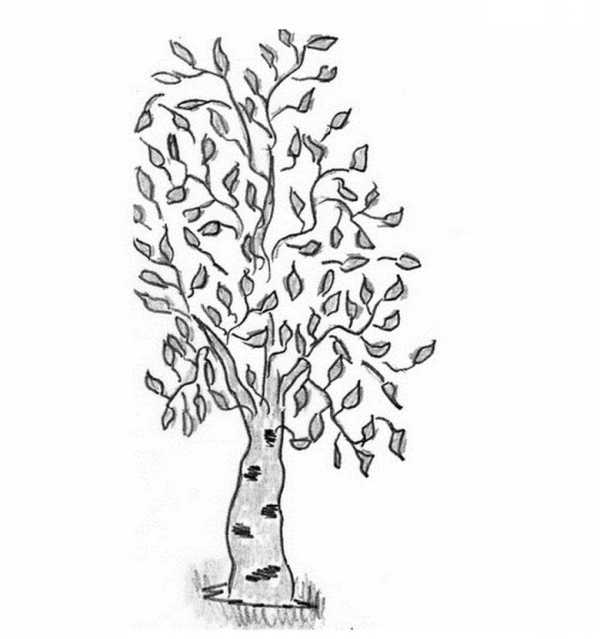
- Draw the branches. They should start from the trunk and branch out in different directions. The branches should be thin and flexible. They can be slightly curved.
Don't draw all the branches in detail, as this will complicate the drawing. It is enough to mark the main directions and add some small details, such as small knots and buds.
- Draw leaves from the crown, gradually moving to the lower branches. Leaves can be made thin and narrow, but long enough. Birch leaves are located on the branches alternately.
- Draw black stripes on the trunk, called lenticels. To create the effect, you can use light pencil strokes. The strokes should be located along the trunk, imitating the natural structure of the bark.
- Draw a small lawn around the birch tree trunk. The grass should be green and slightly rounded.
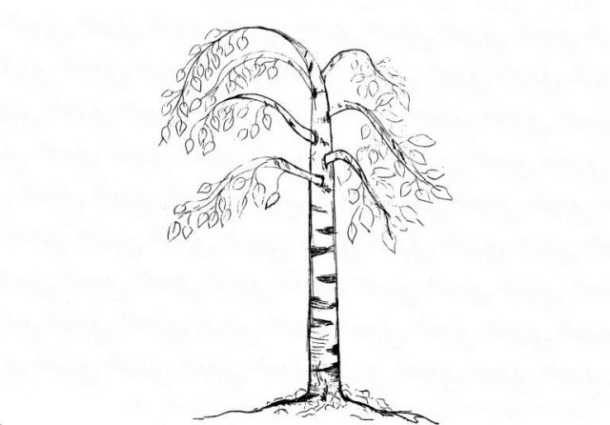
- Use soft lines and shading to create the effect of volume.
Birch forest with watercolors
Using the steps below, you can paint a colorful and detailed birch forest in watercolor. Pay attention to details and harmonious color combinations.
Watercolor allows you to achieve smooth and natural transitions:
- Make a sketch of the future drawing with basic elements, such as the contours of the trees and the general outline of the forest. To create a sketch, you can use a pencil or a thin brush to mark the lines of the trunks, branches and foliage.
It is important to pay attention to the composition and proportions of the elements.

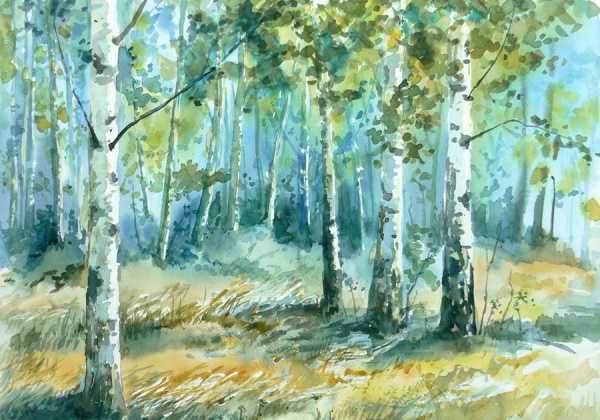
- Go to the image of the birch trunks. The trunks should be thin, straight and vertical. Add the trunks using light brown or yellow. Use a darker shade to draw the relief of the bark, imitating its roughness and unevenness.
- Draw the branches. They should look natural and flexible. Depending on the angle at which the sun's rays fall, the branches can be more or less contrasting. They should be thin enough and not overload the composition of the drawing.
- Draw foliage on the trees. There should be a lot of leaves, they should create a sense of volume and depth of space. Think about their shape and location to create a natural look of a birch forest.
- To add some extra texture to the design, add black lenticels to the birch tree trunks. These little holes in the tree bark will create an interesting contrast with the brown color of the trunk.
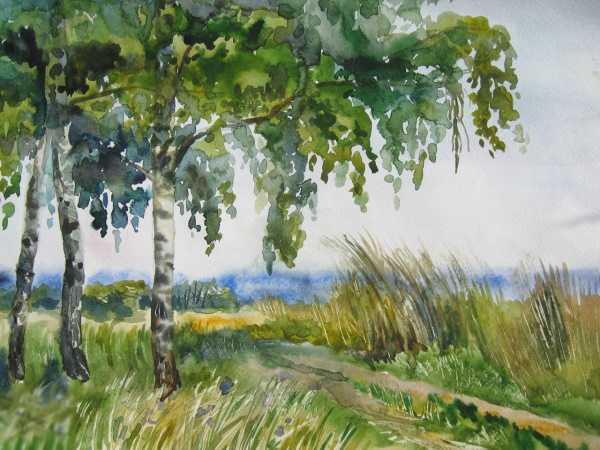
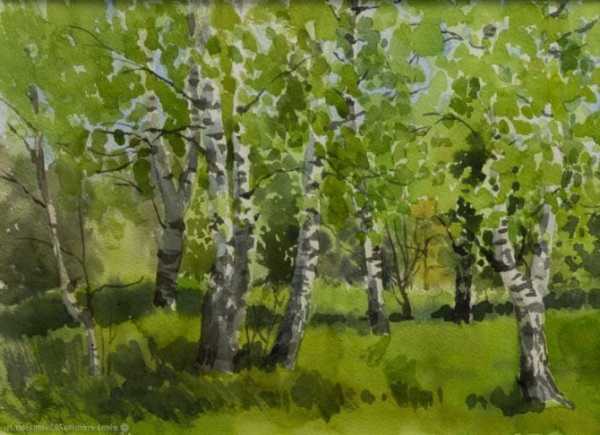
- Add grass under the trees. Use light shades of green to create the effect of sunlight shining through the leaves. The grass should look thick and tall.
- Start coloring. Choose colors for foliage, bark, and grass. Color carefully and gradually to avoid abrupt transitions between colors. You can add a shadow to make the drawing more voluminous and realistic.
Tips for Beginners
The table contains recommendations that will help you create a realistic image of a birch tree using pencils or paints:
| Stages | Comments and recommendations |
| Define style | It can be a realistic drawing, where all the details are well-developed, or a stylized one with simplified forms. Choose the style that matches your skill level and creative vision. |
| Make a sketch | Start with the basic outlines of the trunk, branches and leaves. You can make rough lines - this will help you understand the overall composition and proportions of the tree. |
| Work out the details | Use pencil or paint to create the texture of the tree. Add details such as small bends in the branches and unevenness in the bark. |
| Finish work | Add the finishing touches to complete the drawing. Make sure that all the elements fit together harmoniously and do not overload the drawing with unnecessary details. |
| Experiment with perspective | To make the drawing more interesting and expressive, you can use different types of perspective. For example, draw a birch trunk as if it goes into the distance, creating a sense of space. |
| Add texture | To give the drawing more depth and realism, use different types of lines and hatching. This will help create the effect of shadow, volume and texture. |
| Use light and dark shades | When working with paints or pencils, experiment with different shades of green. Light shades can be used to depict illuminated parts of the tree, and dark shades for shaded ones. |
| Work in stages | You can't draw the entire birch tree at once. Work on each element separately, gradually moving from large details to smaller ones. This will allow you to maintain control over the drawing process and achieve a higher quality result. |
Birch is not only a beautiful tree, but also a useful one. It provides shade, protects from the wind and enriches the air with oxygen. By drawing a birch, you can express your love for nature and the world around you.
Video about drawing
Birch - drawing:
